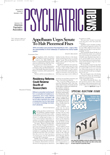A blossoming field of research on posttraumatic stress disorder (PTSD) has yielded extraordinary advances in the last 25 years in understanding the disorder and the best ways to treat individuals exposed to traumatic events.
Enormous gaps remain, however, when it comes to responding to events in which many thousands or even millions are exposed—a lesson brought home on September 11, 2001.
In a lecture last month at APA’s 2003 Institute on Psychiatric Services in Boston, Terence Keane, Ph.D., said advances in understanding the nature and prevalence of PTSD and the role of biological and psychological predispositions in development of the condition have emerged in the last two-and-a-half decades, along with some consensus about optimal treatments for individuals with the condition.
But the terrorist attacks on American soil and the repetitive televised exposure of millions to those events sparked enormous interest in PTSD on the part of governments and public health agencies.
Moreover, the exposure has raised complex questions about the proper response to mass traumatic exposure: Who should receive treatment? What groups are at greatest risk? Should interventions be compulsory? Who should deliver the interventions? Should intervention be at the individual level? When should these interventions be delivered?
“We need to develop and promulgate public-health, population-based strategies for responding to mass exposure to traumatic events,” Keane said.
He is a professor and vice chair of research in psychiatry at the Boston University School of Medicine and chief of psychology and the director of the National Center for Post-Traumatic Stress Disorder in the Veterans Affairs Boston Healthcare System.
Keane noted that considerable controversy, for instance, has emerged around the proliferation of “critical incident stress debriefing”—the practice of mental health personnel arriving at disaster sites to counsel victims of, and witnesses to, disaster.
The practice had its origin in fire departments seeking to provide assistance to firefighters whose jobs, as Keane said, consisted of “95 percent boredom and 5 percent terror.” The practice of critical incident stress debriefing was intended to help avert adverse reactions among firefighters following a traumatizing incident.
“It was a modest intervention, but it caught fire, if you will, internationally,” Keane said. “Police and fire departments, counties, and emergency preparation agencies began to require critical incident stress debriefing. All of this occurred in the absence of any empirical support that it actually did prevent adverse outcomes.”
Keane said the few studies that do exist suggest that the effects of the practice are quite minor, and a few studies identify a subgroup of people who actually got worse following critical incident stress debriefing.
The public-health benefits, if any, of the practice lie in the fact that it can be done with a relatively large number of people following a traumatic event. More successful, though, has been the practice of “problem-focused intervention”—a more lengthy, in-depth, and individualized intervention requiring up to six hours of one-on-one treatment by a trained mental health professional.
“It is clear that the best practices are not established [for response to mass exposure],” Keane said. “We don’t know whether problem-focused interventions are the best. We don’t know whether critical incident debriefing is the right thing because it can be applied with large groups of people. We don’t know whether Internet-based interventions are effective.
“Another major recognition at the time of September 11 was that the mental health workforce is not trained to deal with disasters. And it is largely not trained to deal successfully with acute stress disorder or posttraumatic stress disorder.”
Despite concerns over mass trauma related to disaster and terrorism, Keane described remarkable strides in understanding the nature of PTSD itself. A fairly clear consensus has emerged about the best way to treat individual patients exposed to traumatic events, he said.
One fact that has emerged in the last 20 years is that PTSD is not in all cases the transient phenomenon it was once believed to be. Keane cited statistics showing that half of all patients who develop PTSD recover within the first six to 12 months.
“But the inverse,” he noted, “is that almost half do not recover. Somewhere between 30 percent and 40 percent of those with PTSD continue to have the condition five years later, which really does cause us to challenge the notion that this is transient.”
Research has also revealed that PTSD is associated with significant psychiatric comorbidity. “It is the anxiety disorder associated with the greatest loss for the individual and cost to the society,” he said. “It is a major public health problem for clinicians and public policymakers.”
Some 25 randomized, controlled trials of potential therapies have shown that exposure therapy—in which patients are assisted in facing the images, thoughts, and cues associated with traumatic events—produces statistically and clinically significant reductions in PTSD symptoms. Cognitive behavioral therapy (CBT) has also proven successful, and some studies show that a combination of exposure therapy and CBT is best, Keane said.
Other less-proven therapies include anxiety coping skills training, “eye movement desensitization and reprocessing,” relaxation therapy, and narrative therapies.
Keane also said several large cohort studies have shown SSRIs to have a modest but clinically meaningful impact on symptoms.
Keane urged psychiatrists interested in learning more about advances in treatment of PTSD to visit the Web site of the National Center for Post-Traumatic Stress Disorder at www.ncptsd.org. ▪
